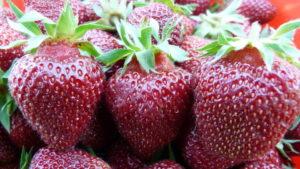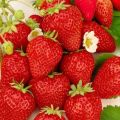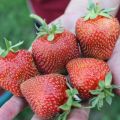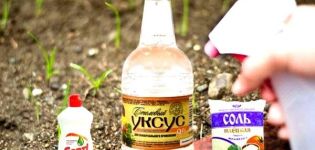Description of the remontant variety of San Andreas strawberries, planting and care
The repairing strawberry variety Albion has been delighting summer residents with its berries for many years. But with a closer acquaintance with it, gardeners revealed the annoying disadvantages of the variety - low frost resistance, weak resistance to spotting and oak berry. And the improved novelty that appeared aroused widespread interest. The American San Andreas strawberry variety has become a faithful assistant for both ordinary summer residents and large farmers.
Characteristics and description of Strawberry San Andreas
The variety of neutral daylight hours was bred in 2001 by American breeders D. Shaw and K. Larson. The strawberry is patented and owned by the University of California. Parents when crossing were two varieties. This is the already well-known neutral Albion and the license plate Cal 97.86-1. Available on the market since 2008. Named after a geological fault that runs throughout California.
Roughly speaking, this is an improved Albion. All the weak points were taken into account, and in the new variety, the breeders tried to fix everything. And they succeeded in many ways.
Flavor and sugar content
Strawberry fruit taste at a high, stable level. Unfortunately, the variety does not reach very tasty remontants such as Murano, Cabrillo, Marighetta. And his parent - Albion - loses a little on this indicator. But it is also impossible to call its berries ordinary.
When trading on the markets, the berries are sold out. For personal consumption, it is advisable to let the fruits ripen well, even to overripe a little. Then the taste will be great. The sugar level in fruits (Brix) ranges from 7 to 10%, depending on the ambient temperature (description of the originators).
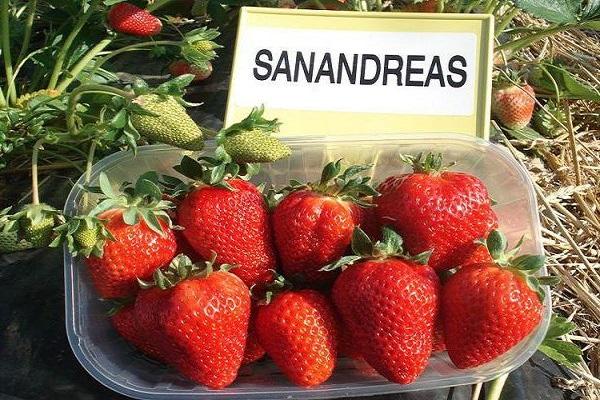
Description of the bush and ripening time
The plant has strong vigor, but the bush is quite compact. Strawberries are on average 25 centimeters high and 30 centimeters wide. The leaves are serrated, large, moderately pubescent, dark green in color. Moreover, at the beginning of the growing season, they are darker than in the following months. The flowers are large, white.
Peduncles are long, strong, hold unripe berries on the weight. Moreover, the variety produces up to ten peduncles at once. As the fruits ripen, the peduncles lie on the ground.Recommended planting pattern: 30-35 centimeters between plants in a row and from 50 centimeters between rows.
The fruits are beautiful, fleshy, uniform and uniform. They are conical in shape, bright red in color, with shine. The berries are large and very large, the strawberries are of a spectacular size, on average, weighing 25-30 grams. But the fruits can be poured up to 50-60 grams. Not every remontant strawberry can do this.

San Andreas ripens at the same time as early varieties of one-time fruiting. In the southern regions - in the first ten days of May, in the Central zone in late May and early June. Strawberry fruiting continues until late autumn. Often, the bushes leave in winter - with unripe berries and color. The greenhouse will help significantly extend the berry season and shift the start of spring fruiting by a month.
Advantages
Despite the abundance of more delicious new products, the American is not losing ground on the market. All strawberries, and even more remontant ones like San Andreas, quickly deplete their resource. But he is able to bear fruit successfully in the second year. And in a protected ground, under conditions of heating and additional lighting, fruiting will last almost all year round.
Influence of rains
This variety has a dense, strong berry with a firm, elastic skin. Therefore, during the rains, the berries do not rot for even a couple of days. They retain their structure and commercial qualities. But for safety net, of course, it is better to use mulching the beds.
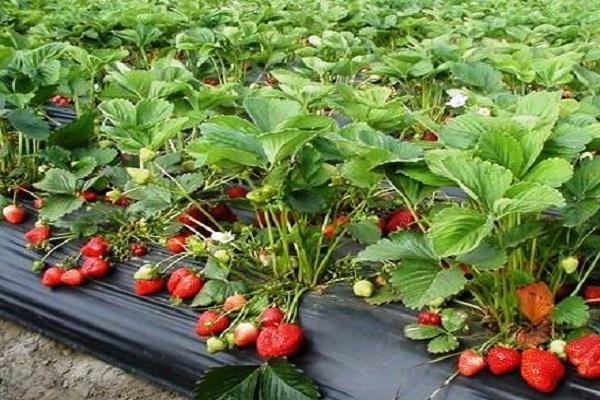
Yield
San Andreas has high and stable yields. In experimental fields in California, a maximum yield of 3.29 kilograms per bush was obtained in a year. In the conditions of our country, productivity per bush, on average, is 1.0-1.2 kilograms. When growing strawberries in protected ground conditions (in film, polycarbonate, glass greenhouses), productivity indicators are much higher.
The gardener decides for himself where it will be more expedient for him to grow the variety.
Influence of negative weather factors
The variety shows stable and high resistance to adverse external conditions. Berries retain their firmness for a long time in high humidity and cool weather. During storage, the fruits are resistant to decay. Resistant to sunburn. Strawberry frost resistance is at a high level.
Positive and negative sides of the variety
There are no ideal plants. Like any strawberry variety, San Andreas has its pros and cons. But it compares favorably with many in that there are much more of these advantages. But even its negative aspects do not interfere with taking leading positions. Moreover, both in summer cottages and in industrial fields.

Positive sides:
- Beautiful, aligned, one-dimensional berries.
- Large and very large fruits that retain their characteristics throughout the season.
- High, stable yield, early spring ripening.
- Drought and heat resistance of the variety, resistance to negative external factors.
- The ability to successfully bear fruit both in open and protected ground.
- Stable resistance to major diseases and pests of garden strawberry.
- Possesses high frost resistance, keeping quality and transportability indicators.
Negative sides:
- In the hot summer months, the taste of strawberries becomes bland, and the fruits do not gain the desired size.
- With intensive cultivation of San Andreas, it is recommended to renew the plantings annually. But if you do not overload the plant, you can grow another year without problems.
- Sugar values vary depending on the ambient temperature.
- To unleash its full potential, full and regular feeding of the variety is necessary.
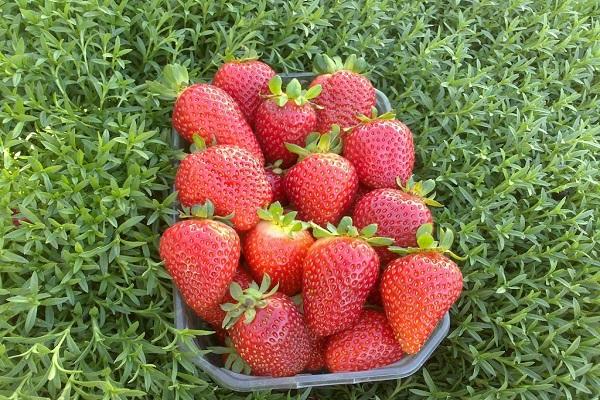
How and when to plant?
Seedlings with an open root system are planted in the spring, immediately after the frost has receded, so that the plant fully takes root before the summer heat. In autumn, planting is carried out from late August to early September. Seedlings with a closed root system (in pots) can be planted throughout the season.
Preparing the beds
Before planting strawberries, the beds are carefully weeded, mineral and organic fertilizers are applied. Plowing or digging of the soil is carried out, followed by abundant watering.
The choice of planting material
When choosing seedlings with open and closed root systems, you should pay attention to the following:
- The thickness of the heart must be from 1 centimeter or more.
- Choose seedlings with a well-developed, fibrous root system.
- The roots should be white or light brown.
- Visually, there should be no traces of disease or pests.
- When choosing seedlings in pots, powerful, stocky plants with a developed leaf apparatus are preferred. The color ranges from green to dark green.
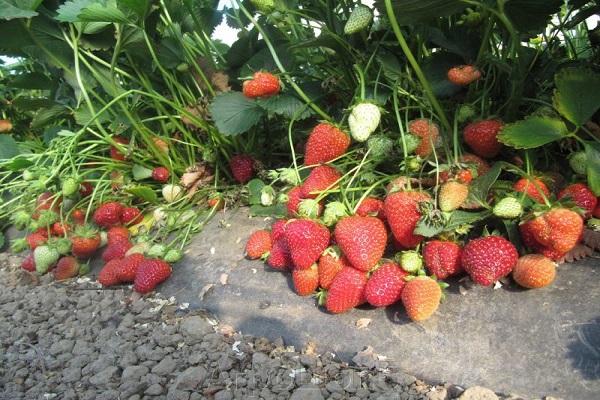
Landing technology
Seedlings with a closed root system are planted in a pre-prepared hole flush with the ground. The tangled roots at the bottom of the pot are straightened slightly. Seedlings with an open root are placed in the hole so that the heart is at the soil level. Not lower and not higher. When planting, the roots are straightened, and the hole is covered with soil. After planting, the plants are watered abundantly.
How to properly care for your culture?
To obtain high yields of delicious berries, San Andreas requires careful and proper agricultural technology. The plant responds positively to competent care.
Watering and feeding
San Andreas, like all remontants, requires regular fertilizing with complex fertilizers every 10-14 days. Depending on the phase of development of strawberries, the formula of the applied fertilizers also changes. Watering, especially at the time of fruiting, should be regular. In summer, as the soil dries up, depending on the composition of the soil. On sandy soils, at the peak of the heat, watering is carried out even after 1-2 days.
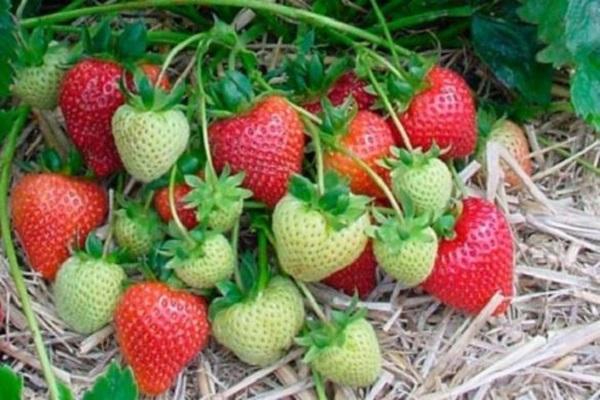
Weeding and loosening
To maintain health and provide air to the strawberry root system, weeding and surface loosening of the soil should be carried out 2-3 times a month. On mulch plantings, loosening and weeding is carried out only in the aisles.
Mulching
The variety responds positively to mulching the beds. This allows you to keep moisture in the soil in the hot summer months, protects the root from overheating. Mulch prevents unwanted weed growth, protects berries from gray mold in rainy and damp weather. Straw, green manure cuttings, black film, white and black agrofibre will do.
An excellent, albeit not cheap, option would be to mulch with agrotex.
Wintering
San Andreas has high frost resistance. Up to -20 C degrees, it can winter without shelter. Especially in regions with snowy and frosty winters, without frequent thaws. But for safety reasons, it is advisable to shelter the beds for the winter. Moreover, under agrofibre, its own microclimate is formed, accelerating the ripening of strawberries up to 2 weeks.

Disease and pest control
Resistant to many diseases and pests of strawberries. In particular, to spot and strawberry mite. To maintain plant health, it is recommended to carry out preventive treatments against diseases and pests several times per season. For example, a mixture of 1 fungicide and 1 insecticide. At choice: Switch, Horus we combine with Aktellik, Engio, biological product Aktofit.
It is worth paying special attention to such a dangerous pest as the larva of the May beetle. Or simply - Khrushchev. Watering 2-3 times per season under the root with a solution of the drug Aktara, Antichrushch, Nurell D. If there is an ovary or berries on the bushes, it is important to use only biological products!
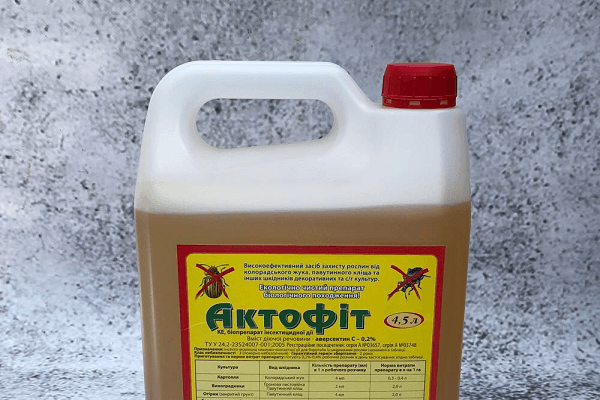
Strawberry propagation
If the goal is to obtain the maximum number of seedlings, then annual planting renewal is mandatory. On mother plants, all flowers and ovaries are regularly removed so that the plant gives off strength for growth and vegetative propagation. We recommend weekly spraying and root watering with high nitrogen fertilizers. For example, Plantafol (Planter) with the formula 10/30/10.
Repaired varieties and, in particular, San Andreas are recommended to be renewed annually so that the plant has a lot of whiskers.

Growing Difficulties and Care Tips
San Andreas is a large-fruited remontant variety, therefore, in order to achieve high yields, it requires competent agricultural technology. Regular provision of moisture, spraying and watering with fertilizer solutions under the root and on the leaf. Plus preventive treatments for diseases and pests and soil mulching. There are no special problems in the cultivation of this strawberry.
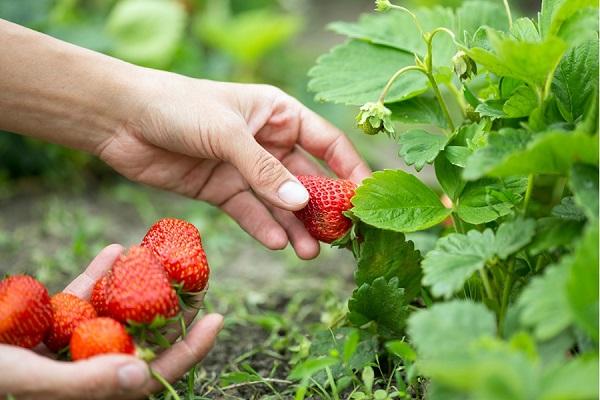
Fruit harvesting and storage rules
In the summer months, strawberry harvesting is carried out in the early morning hours or in the evening, when solar activity has already subsided. The berries picked in the heat are worse in taste and quality, and spoil faster. In case of early spring or autumn sampling, on the contrary, it is advisable to pick the berries when the sun's rays heat them up, drying the morning dew from the fruits.
The berries are collected in plastic booties (1 and 0.5 kilograms) or small, cardboard flat boxes with a capacity of up to 5 kilograms. In this case, transportability and keeping quality will be maximum. After harvesting, it is advisable to cool the fruits, if possible. This procedure further enhances the commercial characteristics of the strawberries during subsequent transportation.

